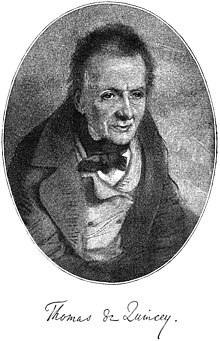Opium and Romanticism
[1] The fascination and experimentation with opium occurred partially because of its connections to the oriental tales such as Purchas his Pilgrimage, Travels through Persia, and Memoires du Baron de Tott, sur les Turcs et les Tartares ("Baron de Tott's memoires - on the Turks and the Tartars"), in which opium use was emphatically featured.
[6] These patent medicines included Godfrey's Cordial, Dalby's Carminative, McMunn's Elixir, Batley's Sedative Solution, and Mother Bailey's Quieting Syrup.
[9] Browne's contemporary, the physician Thomas Sydenham (1624–89) the so-called 'Father of British medicine' declared - Among the remedies which has pleased the Almighty God to give to man to relieve his sufferings, none is so universal and so efficacious as opium .
One section of his paper describes how opium was believed to treat pain, cause sleep, increase perspiration, raise the spirits, and relax the muscles.
At the time of George Crabbe's first prescription, the East India Company began hiring Indian Villages to cultivate large quantities of opium.
[13] William Cullen and John Brown, two well-known physicians at the time, claimed it cured things such as typhus, cancer, cholera, rheumatism, smallpox, malaria, venereal disease, hysteria, and gout in the eighteenth century.
[15] A deeper medical analysis revealed that opium created and uplifted spirit and happy disposition, which was then followed by symptoms of a very opposite effect which includes the mind "becoming gradually dull and languid, the body averse to motion, little affected by customary impressions, and inclined to sleep".
Following a larger dose, "all these symptoms continue to increase; and tremors, convulsions, vertigo, stupor, insensibility, and deprivation of muscular action appear".
[18] This was especially true within the circle of Romantic poets, specifically Samuel Taylor Coleridge and Thomas De Quincey, who suffered from addiction to opium.
[23] A recent argument put forward by Alethea Hayter suggests that opium opens up the individual's mind toward recollecting the raw materials found within one's own life and the dreams, reveries, or hypnagogic visions, and the results are then translated into art.
The necessary tools to create work like that of the opium-fuelled Romantic poets therefore must include not only the ability to daydream under the influence of the drug, but also the necessity of being able to communicate those visions on paper later.
[27] It has been proven or suggested through letters and notebooks that George Crabbe, Samuel Taylor Coleridge, Thomas de Quincey, Lord Byron, John Keats, and Percy Shelley imbibed on opium, whether for medicinal or recreational uses.
When Shelley secretively began to become romantically involved with Mary Wollstonecraft Godwin, he started to carry a flask with laudanum in it around to calm his nerves.
After Shelley was banned from seeing Mary, he reportedly ran into her house and gave her laudanum, waving a pistol in the air and shouting, "By this you can escape Tyranny.
Shelley began experiencing body spasms and upon visiting his new doctor, Andrea Vacca Berlinghieri, he was warned to stop taking laudanum.

